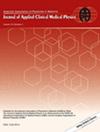Surface dose analysis and dosimetric comparison of Halcyon versus Truebeam in breast cancer radiotherapy: An OSL dosimetry study
Abstract
Purpose
Breast cancer is a neoplastic disease with high prevalence among women. Radiotherapy is one of the principal treatment modalities for this disease, but it poses significant challenges. This study aimed to compare and evaluate the technical and dosimetric performance of conventional C-arm linac systems and a new design, Halcyon, in the context of breast radiotherapy.
Methods
The study included ten patients who had undergone left breast radiotherapy. Additionally, breast radiotherapy was simulated with an anthropomorphic phantom, and similar planning studies were performed. A total of 40 treatment plans were prepared for ten patients using the field-in-field (FinF) and volumetric modulated arc therapy (VMAT) techniques on both TrueBeam and Halcyon systems. Subsequently, treatment plans were created for anthropomorphic phantoms using both techniques on both devices. The dosimetric comparisons were conducted on treatment plans with different treatment techniques on both devices. An anthropomorphic phantom was employed to ascertain the surface dose during treatment, with irradiation conducted in the following with the OSL dosimetry method.
Results
Patient plan comparisons showed no statistically significant differences in planning target volume (PTV) outcomes between techniques and devices. Upon analysis of the organ at risk (OAR), statistically significant differences were identified for FinF in both devices for low-dose regions. Analysis of the OSL results obtained from phantom irradiations revealed that the Halcyon results were higher than those obtained with the TrueBeam for both techniques. Additionally, a comparison of OSL results with the TPS data revealed discrepancies of up to 18% within the field and up to 22% outside the field. Furthermore, Halcyon demonstrated higher Monitor Unit (MU) values for both techniques, while still maintaining shorter treatment times.
Conclusion
The Halcyon demonstrated comparable technical and dosimetric outcomes to conventional C-arm linac in breast radiotherapy. Its distinctive design features contribute to the implementation of efficient and secure treatment modalities.

 求助内容:
求助内容: 应助结果提醒方式:
应助结果提醒方式:


